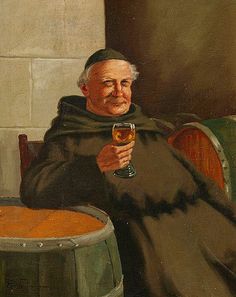Middlefart Denmark gets a lot of visitors, usually schoolboys and older men who haven't quite grown up. Their interest is scatological rather than in the town's renowned sites like Middelfart Church, dedicated to St Nicholas, which has a Late Romanesque chancel first constructed in the 14th century and a nave with aisles from the late 15th century. or the Henner Friiser Hus, a half-timbered house dating from around 1575.

Our interest today in Middlefart is neither in history nor toilet humour as The Curmudgeons Inc.ⓒ prides itself on maturity and sophistication. No, in the third of the series THE MORE OBSCURE CATHOLIC SAINTS our interest is in Padre Pardonme of Middlefart the patron saint of flatulance.
Born in 1456 Padre Pardonme, or Pooh as he was known to his friends and family was brought up comfortably in a middle class or bourgeoise environment. His father was a burgher who had made his fortune initially as a butcher and then as controller of the town's bakeries, charcuteries and other food suppliers. Pooh was a chubby child by nature with a voracious appetite and the access to rich foods, particularly processed meat products soon added to his girth so that by the time he was about to leave school at the age of fourteen, Pooh was grossly overweight.
While being overweight in Renaissance times was seen to be a position of fortune and worthiness rather than anything to be ashamed of, Pooh was nevertheless the butt of jokes from his peers who called him Porky Pooh or 'Squeeze me' which, in local dialect was a kind of pun on his given name Pardonme. Pooh though, had a good sense of humour not unknown in people of his endomorphic propensity. With his voluminous gastric cavities aided by significant amounts of processed pork product, Pooh naturally expelled more intestinal gas than normal, a fact well known to him and anyone who was close by. Pooh then, through the frequency of his flatus and his sense of humour managed, by dedicated practice, to control the pitch, tone and duration of them not unlike how musicians do with their musical instruments particular the A-toned ones. In time he was able to perform little tunes to entertain his friends and to hopefully diminish their mean jokes.
In the time of the Renaissance, music was primarily religious and was used to carry the words of prayers. Pooh's source material was limited and the 'tunes' short which was probably just as well for his friends who huddled in close to listen to Pooh's renditions. Some of Pooh's best interpretations were:
Good Food Prayer
Good food, good meat, good God, let's eat!
Secret Kitchen Dinner Prayer
Dear Lord,
as you know, we asked those who we knew could make a meat dish sublime, and those who we knew
prepare questionable meals all the time, each to do their part, so none would feel left out, the real cookers, will bring the meat dishes, excuse us Lord, the others will wash them out.
We thank you God for this meal. Bless our thoughts to be truthful and our words to not be mean, we just want this dinner to be one of the best we've seen. Amen.
The boys and girls huddling together caught the attention of the priest Father Inthebetta, a Jesuit on secondment from Rome who was charged with increasing the numbers at Mass (and getting the offertory takings up). Father Inthebetta listened to the 'tunes' and, as the church organ fund was sorely lacking, saw Pooh's renditions as a great drawcard for the congregation who hadn't yet discovered 'NOT' jokes and could do with a bit of a laugh.
Pooh was indoctrinated into the mysticisms of the clergy and taught the miracles of transubstantiation, confirmation, confession and a lot of other made up things. Father Inthebetta also taught Pooh about pyramid schemes, diamond necklace hoaxes, selling of indulgences, instant finace and how to promise to withdraw before .... well, you know. Pooh was a quick learner and, under Father Inthebetta's tuition and mentorship rose quickly in the church's ranks and the esteem of Rome as takings, both legitimate from the Sunday collection and tithing and illegitimate from the on-the-side selling grew the Church's coffers.
Pooh or, Padre Pardonme of Middlefart died early due to health issues that were not properly understood at the time. His legacy, along with his corpse was enormous however and the reigning pope Pope Addom of Vijayanagara was easily persuaded to canonise Pardonme who is now the official patron saint of flatulence and, in honour of his father, hamburgers.



















.jpeg)


